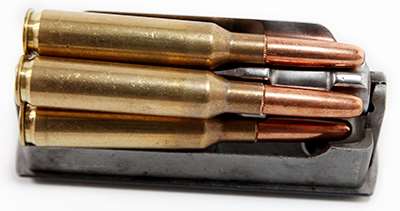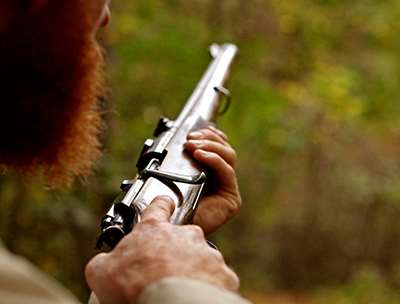
“A gun is to shoot anyway, he thought, not to be preserved in a case, and this was a really good rifle, easy to shoot, easy to teach anyone to shoot with, and handy on the boat. He had always had more confidence shooting it, as to being able to place his shots at close and moderate range, than any other rifle he had ever owned and it made him happy to pull it out of the case now and pull back the bolt and shove a shell into the breech.”
—Ernest Hemingway, Islands in the Stream
Good means “adequate.” A good car is one that gets you to work every day, picks up the kids after school, hauls the groceries twice a week and starts every time you turn the key. A good rifle goes bang every time you pull the trigger, fires a cartridge that accomplishes what it was intended for and lets the average shooter put all of his rounds into an area the size of a dinner plate at 100 yds. As a hunter, Ernest Hemingway owned and used some of the best firearms the 20th century had to offer—guns with names such as Griffin & Howe, Westley Richards and Boss engraved on them. He understood the difference between “good” and “really good.” Good gets the job done. Really good reaches down and touches something deep inside you while it’s getting the job done. For a man like “The Man” to add the adverb “really” to a rifle he calls “good” is something to take note of.
 It certainly caught my attention when, as a 12-year-old, I first read those words tucked in the middle of a battered old paperback I pulled off my grandfather’s bookshelf. By designating it a “really good rifle” Hemingway had ignited my fascination and started my search for the gun known as the Mannlicher-Schoenauer.
It certainly caught my attention when, as a 12-year-old, I first read those words tucked in the middle of a battered old paperback I pulled off my grandfather’s bookshelf. By designating it a “really good rifle” Hemingway had ignited my fascination and started my search for the gun known as the Mannlicher-Schoenauer.
It was at Griffin & Howe’s Manhattan store, where his custom Springfield had been built, that Hemingway first discovered the Steyr-made 1903 Mannlicher. The little Austrian carbine that he purchased was expensive, twice what a contemporary Remington Model 30 or Winchester Model 54 would have cost him. Before it left the shop, Hemingway had the rifle modified by converting the double set triggers to a single arrangement and adding a scope mount. In 1933, it was part of the arsenal that accompanied Hemingway on his first African safari, which he detailed in his non-fiction work, The Green Hills of Africa. Among the exploits he notes in the book is his wife Pauline shooting her first lion with “the little Mannlicher.”
Hemingway’s use of the carbine continued after the safari, as detailed in his personal letters from the 1930s. In 1935 he was in the Bahamas using the Mannlicher to dispatch sharks that were going after his trophy bluefin (“… the sharks hit him. 5 hit him at once. I shot 3 with the Mannlicher but they cut him up like a log in a planing mill.”). In 1936 he was in Wyoming, taking two antelope at 300 and 600 yds. (“… both running, dead, one-shot mannlicher.”).
Hemingway’s fascination with the Mannlicher-Schoenauer found its way into his fiction. In his famous short story The Short Happy Life of Francis Macomber, the namesake character is killed by his 6.5 Mannlicher-wielding wife. The rifle figures large in Hemingway’s novel Islands in the Stream, where main character Thomas Hudson uses his Mannlicher to fight off a hammerhead that attacks his son.
In real life, Hemingway owned at least two 1903 carbines, as well as a post-war 1952 carbine in 6.5x54 mm M-S. In 1997, Butterfield and Butterfield sold Hemingway’s second 1903 carbine for a mere $6,325.

A few years after my initial encounter with Islands in the Stream, I purchased my first Mannlicher-Schoenauer. Abandoned on the parts rack of a gun shop, I found the military version that had been used by the Greek army. It had been butchered down to a crude sporter and showed the signs of years of neglect, but it was marked “Steyr” on the receiver and opening the action revealed the beautiful rotary magazine hidden beneath the bolt. It was not a 1903 carbine, but it was as close as my budget would allow and was one step closer to the rifle of Hemingway.
Over the years the old Greek rifle stayed tucked away in the back of my safe, as Hemingway’s description of his beloved rifle stayed filed somewhere in the back of my mind. While I daydreamed of finishing the work on the army rifle that had begun in someone’s garage, I kept searching for an original Mannlicher-Schoenauer carbine.

My chance finally came when an online auction advertised, in grainy cell phone pictures, what looked to be a well-used 1903 Mannlicher. The price was low, so I took a chance, placed a bid and waited. When the rifle arrived a few weeks later I eagerly removed it from its case. I could describe what I found, but I’ll leave that to Hemingway:
“It was a .256 Mannlicher Shoenauer with the old eighteen-inch barrel they weren’t allowed to sell any more. The stock and forearm were browned like a walnut nutmeat with oil and rubbing, and the barrel, rubbed from months of carrying in a saddle bucket, was oil-slick, without a spot of rust. The cheek piece of the stock was worn smooth from his own cheek and when he pulled back the bolt the revolving magazine was full of heavy bellied cartridges with the long, thin, pencil-shaped metal-cased bullet with only a tiny exposed lead tip.”
Poor-quality photos had concealed a nice, little rifle that was made in 1928, probably around the same time that Hemingway’s Mannlicher was built at the Austrian factory. The rifle’s German proofmarks mean it probably came to this country with a returning G.I. after World War II, but that part of the story, and how it ended up in a Las Vegas pawn shop, will never be known. Of course the unknown is a green light for the imagination. The toe of the stock held a little plate engraved with the initials “RH.” If I stare at it long enough the ”R” begins to look like an ”E”.
I collected some brass and a box of 160-gr. round-nose bullets and headed over to the range of a friend who happened to have a set of dies. On his bench, my hands grasped the worn checkering on the pistol grip and fore-end, the steel buttplate settling into the pocket of my shoulder, my cheek bone cupped by the buttstock, the awkwardness of a new rifle melting into the embrace of an old friend. Ahead of the gold front-sight bead, the paper target faded into the gray of a hammerhead fin slicing through blue Caribbean water. I pulled the set trigger until it clicked, paused my breathing and eased my finger forward to the hair trigger. It would be a shot that was two decades in the making—the crack of the 6.5 mm bullet leaving the barrel marked the end of one journey and the beginning of a new one. This rifle, the rifle, was now mine to care for, to shoot, to hunt with and to add to the honest wear that graced its wood and metal by walking in the footsteps of the hunters and adventurers like Hemingway, who have carried 1903 Mannlichers in the field for over a century.

Understand the draw of fine old firearms such as the 1903 Mannlicher-Schoenauer and you understand why guns are such an integral part of the outdoor experience. It’s the romance and the history, the opportunity, through an object, to connect ourselves with great things that happened a long time ago and the chance to make our own mark on that story.
I slipped my palm beneath the Mannlicher’s butterknife bolt handle, lifted it skyward and effortlessly worked the bolt to chamber another round. At 50 yds. the first two shots I fired were nearly touching. I went back to the press to load a few more.
Hemingway was right. It is a really good rifle.
Read more from this American Rifleman article: The History of the Mannlicher-Schoenauer Carbine




































